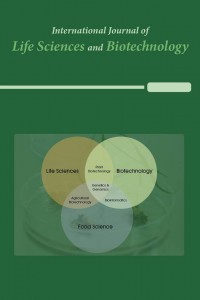Düzeltme:
Düzeltme: Yoghurt production using pinecone and investigation of the effect of the produced yogurt on ECV304 cell line
OBJECTIVE: The goal of this study was to ferment yoghurt from milk using lactic acid bacteria found in pinecones and to examine the cell viability and lipid peroxidation levels of the fermented yoghurt on Vascular Endothelial Cell Line ECV304.
METHODS: ECV304 was cultured in vitro. To determine cell viability, various concentration of yogurt extract fermented with pinecone were given to cultured cells using the MTT Assay. At the same doses as the MTT Assay, the Lipid Peroxidation (LPO) Assay was employed to evaluate the malondialdehyde (MDA) levels of cells. Acridine orange/Ethidium Bromide staining technique was applied to detect apoptosis. Gas Chromatography-Mass Spectrometry was used to identify the volatiles in yoghurt fermented with pinecone. RESULTS: All dosages of pinecone fermented yogurt enhanced cell viability of the human healthy vascular endothelial cell line ECV304 and decreased MDA levels, as validated by fluorescence microscopy pictures. The primary essential oils identified in yogurt fermented with pinecone were hexadecanoic acid, eicosanoic acid, stearic acid, and 2-palmitoylglycerol. CONCLUSIONS: In this work, the effects of yogurt fermented with pinecones on human healthy cell lines were examined for the first time. The study discovered that this yoghurt promotes the proliferation of healthy human cells while decreasing oxidative stress in these cells.
Keywords:
lactic acid bacteria, Lactobacillus delbrueckii subsp. Bulgaricus, pinecone, Streptococcus thermophilus, yoghurt,
___
- 1. Weerathilake, W., et al., The evolution, processing, varieties and health benefits of yogurt. International Journal of Scientific and Research Publications, 2014. 4(4): p. 1-10.
- 2. Division, N., Codex Alimentarius - Milk and Milk Products Second edition. 2011.
- 3. Courtin, P. and F. Rul, Interactions between microorganisms in a simple ecosystem: yogurt bacteria as a study model. Le Lait, 2004. 84(1-2): p. 125-134.
- 4. Tamime, A.Y. and R.K. Robinson, Tamime and Robinson's yoghurt: science and technology. 2007: Elsevier.
- 5. Bautista, E.S., R. Dahiya, and M. Speck, Identification of compounds causing symbiotic growth of Streptococcus thermophilus and Lactobacillus bulgaricus in milk. Journal of Dairy Research, 1966. 33(3): p. 299-307.
- 6. Beshkova, D., et al., Production of flavour compounds by yogurt starter cultures. Journal of Industrial Microbiology and Biotechnology, 1998. 20(3): p. 180-186.
- 7. Ott, A., L.B. Fay, and A. Chaintreau, Determination and origin of the aroma impact compounds of yogurt flavor. Journal of agricultural and food chemistry, 1997. 45(3): p. 850-858.
- 8. Michaylova, M., et al., Isolation and characterization of Lactobacillus delbrueckii ssp. bulgaricus and Streptococcus thermophilus from plants in Bulgaria. FEMS microbiology letters, 2007. 269(1): p. 160-169.
- 9. Yi, J., et al., Preparation optimization and protective effect on 60Co-γ radiation damage of Pinus koraiensis pinecone polyphenols microspheres. International journal of biological macromolecules, 2018. 113: p. 583-591.
- 10. Yi, J., et al., Study on antitumor, antioxidant and immunoregulatory activities of the purified polyphenols from pinecone of Pinus koraiensis on tumor-bearing S180 mice in vivo. International journal of biological macromolecules, 2017. 94: p. 735-744.
- 11. Bostan, K., et al., Identification and characterization of lactic acid bacteria isolated from traditional cone yoghurt. Food science and biotechnology, 2017. 26(6): p. 1625-1632.
- 12. Brown, J., et al., Critical evaluation of ECV304 as a human endothelial cell model defined by genetic analysis and functional responses: a comparison with the human bladder cancer derived epithelial cell line T24/83. Laboratory investigation, 2000. 80(1): p. 37-45.
- 13. Jovanović, M., et al., Bioactivity and sensory properties of probiotic yogurt fortified with apple pomace flour. Foods, 2020. 9(6): p. 763.
- 14. Cebecioglu, R., et al., Synergistic effects of quercetin and selenium on oxidative stress in endometrial adenocarcinoma cells. Bratislavske lekarske listy, 2019. 120(6): p. 449-455.
- 15. Inc., R.D.S., TBARS Assay. 2013. https://www.caymanchem.com/pdfs/10009055.pdf 16. Kasibhatla, S., et al., Acridine orange/ethidium bromide (AO/EB) staining to detect apoptosis. Cold Spring Harbor Protocols, 2006. 2006(3): p. pdb. prot4493.
- 17. Chen, C., H.M. Chan, and S. Kubow, Kefir extracts suppress in vitro proliferation of estrogen-dependent human breast cancer cells but not normal mammary epithelial cells. Journal of medicinal food, 2007. 10(3): p. 416-422.
- 18. Sharma, H., et al., Comparative analysis of metabolites in cow and goat milk yoghurt using GC–MS based untargeted metabolomics. International Dairy Journal, 2021. 117: p. 105016.
- 19. Abdullahi, M., et al., Evaluating the suitability of Adansonia digitata fruit pulp for the production of yoghurt. International Journal of Biological and Chemical Sciences, 2014. 8(2): p. 508-516.
- 20. Fredrickson, J.K., et al., Geomicrobiology of high-level nuclear waste-contaminated vadose sediments at the Hanford Site, Washington State. Applied and environmental microbiology, 2004. 70(7): p. 4230-4241.
- 21. Radke-Mitchell, L. and W. Sandine, Associative growth and differential enumeration of Streptococcus thermophilus and Lactobacillus bulgaricus: a review. Journal of food protection, 1984. 47(3): p. 245-248.
- 22. Yi, J., et al., Optimization of purification, identification and evaluation of the in vitro antitumor activity of polyphenols from Pinus koraiensis pinecones. Molecules, 2015. 20(6): p. 10450-10467.
- 23. Nagaoka, S., Yogurt production, in Lactic Acid Bacteria. 2019, Springer. p. 45-54.
- 24. Benmeziane, F., et al., Lentil (Lens culinaris) flour addition to yogurt: Impact on physicochemical, microbiological and sensory attributes during refrigeration storage and microstructure changes. Lwt, 2021. 140: p. 110793.
- 25. Sonomoto, K. and A. Yokota, Lactic acid bacteria and bifidobacteria: current progress in advanced research. 2011.
- Yayın Aralığı: Yılda 3 Sayı
- Başlangıç: 2018
- Yayıncı: International Society of Academicians
Sayıdaki Diğer Makaleler
İlter DEMİRHAN, Erkan ÖNER, Adem NECİP, Aydın AKTAŞ, Medine ÇOTAK, Yetkin GÖK
Karadeniz Bölgesinin İl Düzeyinde Süs Bitkileri Üretiminin İncelenmesi
Ömer SARI, Fisun Gürsel ÇELİKEL
Leyla GÜVEN, Ufuk ÖZGEN, Handan SEVİNDİK, İclal AĞAN, Mehmet KOCA, İbrahim TURAN, Selim DEMİR, Yüksel ALİYAZICIOĞLU
Abdullahi AJAO, Ganiyat ALASİNRİN
YENİLİKÇİ KENDİNDEN İYİLEŞEN HİDROJEL KOMPOZİT OLARAK AZOT KATKILI KARBON KUANTUM DOTS-GELLAN GUM
Mustafa TOPU, İskender TİRYAKİ
İşlenmiş gıdalar için GDO tespitinde modifiye DNA izolasyon yöntemlerinin karşılaştırılması
